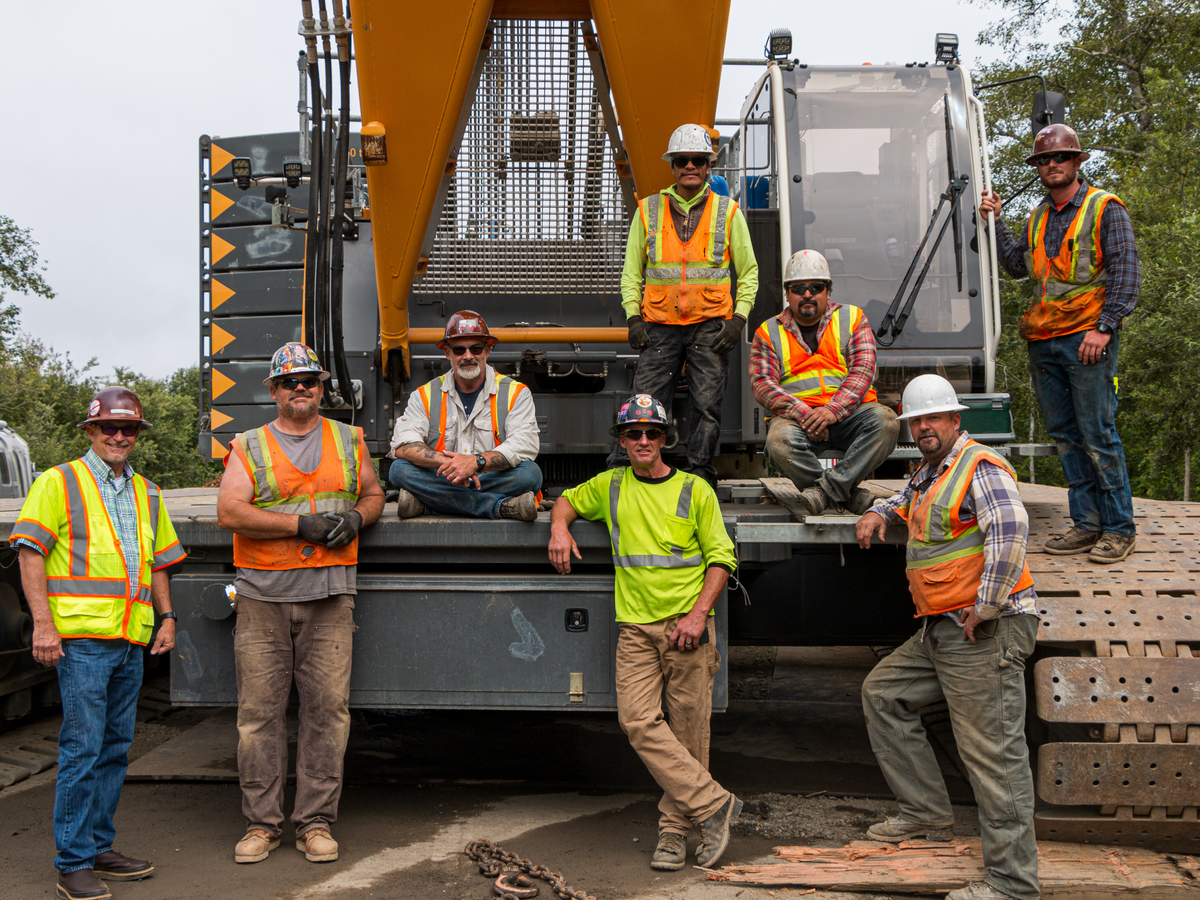
The first nacelles onboard a sea energy “jack-up ship,” ready for lifting into place on the Kentish Flats Offshore Wind Farm, off Whitstable, Kent, England.
Chris Laurens/Construction Photography/ Avalon / Getty Images
hide caption
toggle caption
Chris Laurens/Construction Photography/ Avalon / Getty Images

The first nacelles onboard a sea energy “jack-up ship,” ready for lifting into place on the Kentish Flats Offshore Wind Farm, off Whitstable, Kent, England.
Chris Laurens/Construction Photography/ Avalon / Getty Images
Installation of enormous floating wind turbines needed to turn West Coast ocean gales into clean electricity remains years off, but results of a federal lease auction this month off California promised to kickstart a work boom on the state’s northern and central coasts.
The farming of wind power from American waters will be crucial in efforts to slash emissions of heat-trapping pollution from fossil fuels and ensure reliable supplies of electricity. While offshore wind farms are plentiful abroad and onshore wind energy is common through the U.S., just a handful of offshore turbines have so far been installed with many more planned along the East, West and Gulf coasts and potentially off Hawaii.
The redevelopment of 80 acres of waterfront land in Humboldt County into a hub for offshore wind operators and their vessels is imminent following the auction. Similar work will be needed in Morro Bay, onshore from three planned clusters of wind turbines.
“The work starts now,” said Jeff Hunerlach, a building trades union leader based in Humboldt County after energy companies and joint ventures committed a total of $757 million to develop five floating wind farms clustered into two swaths of open ocean off Humboldt and Morro Bay.
Unions representing electricians, laborers and other trades — groups that for decades were frequently at odds with the green movement — joined environmental groups in celebrating the lease auction’s results.

Jeff Hunerlach (far left) is a district representative at Operating Engineers Local No. 3. He’s shown here with the Golden State Bridge operating engineers.
Jeff Hunerlach
hide caption
toggle caption
Jeff Hunerlach

Jeff Hunerlach (far left) is a district representative at Operating Engineers Local No. 3. He’s shown here with the Golden State Bridge operating engineers.
Jeff Hunerlach
“It’s a brand new industry,” said Hunerlach, district representative at Operating Engineers Local No. 3 and local leader of 16 affiliated locals representing a variety of trades laborers. “For Humboldt,” Hunerlach said,”this means growing the middle class.”
Substantial new waterfront infrastructure will be needed at Humboldt and Morro Bay to bring electricity from offshore wind turbines onto shore, where it will power homes, electric vehicles and industry.
At the Humboldt port, Hunerlach anticipates hundreds of union workers will be employed during construction, with additional permanent jobs once the facility is running. Statewide, he expects the number of jobs created to support the new industry will be in the “tens of thousands.”
The wind farm development rights were secured by large energy companies already developing wind farms on the East Coast, where shallower waters allow for the use of traditional tower-based designs. Some of the winning bidders are transitioning or expanding from fossil fuel to clean energy production.
“On an overall basis for offshore wind, we see the U.S. market as one of the top one or two markets globally that we’ll be investing in over the next decade and a half,” said Sam Eaton, a U.S.-based executive at RWE, a German energy company founded more than a century ago that secured the rights to build one of the wind farms off Northern California.
Other winning bidders included the wind division of Equinor, another energy giant expanding out of Europe, and several joint ventures created to deploy floating wind farms off the West Coast.
“When we focused in on the floating offshore wind space, California’s option really put the U.S. right at the forefront,” Eaton said. “It’s one of the first to hit the kind of scale that we’re talking about and sets up the Western part of the country extremely well to be a hub for the industry globally.”
Best wind potential
While offshore wind power is a significant component of energy industries in Europe and Asia, just a handful of turbines are currently generating power in the U.S.
A belated offshore wind farming boom along the Atlantic, Pacific and Gulf coasts is anticipated in the years and decades ahead, aided by international technology and know-how. Offshore wind energy is also being considered for Hawaii.
Offshore wind farming off the West Coast is complicated by the closeness to shore of the steep continental shelf. Waters viable for wind farming are too deep for the towers that hold most offshore turbines in place worldwide. The wind farms off California will be among the first in the world that float on giant platforms tethered to the seafloor and connected to land through electrical cables.

The floating platforms would be located about 20 miles off California’s coast.
BOEM
hide caption
toggle caption
BOEM
Efforts to build out the new industry will create jobs while providing federal incentives for developers to invest in coastal communities where new infrastructure will be needed. The efforts are however creating clashes with fishing fleets fretful not only of losing hunting grounds, but of broader impacts on their quarry from the new approach to renewables generation.
“We’re going to throw billions of dollars into something that we don’t really know what the impact is going to be,” said Dick Ogg, a commercial fisherman of crab, albacore, black cod and rockfish. He’s based out of Bodega Bay but he chases salmon from the state’s north coast south to Morro Bay, which is another quiet part of California where an infrastructure boom is planned to get electricity from offshore wind turbines to land-based power customers. “We’d like to see a project that is smaller,” said Ogg.

Dick Ogg, a commercial fisherman based out of Bodega Bay, worries about the impact offshore wind will have on the fishing industry.
Aryk Copley/KQED
hide caption
toggle caption
Aryk Copley/KQED

Dick Ogg, a commercial fisherman based out of Bodega Bay, worries about the impact offshore wind will have on the fishing industry.
Aryk Copley/KQED
Fishing fleets nationally are angry about what they say is a lack of consultation with them by wind developers and by the federal government, with hundreds of lobstermen in Maine attending protests about plans there. Tribes, too, say their members are being ignored.
“We’re asking developers to simply view us for what we are: sovereign nations,” said Frankie Myers, vice-chair of the Yurok Tribe. The Yurok have lived in the redwood coast and along the Klamath River in what is now Northwestern California for thousands of years.
Yurok tribal leaders spoke with half a dozen potential developers in advance of California’s offshore wind auction, but Myers said they weren’t consulted by RWE or the other auction winners.
Myers said the worst impacts would be visual impacts from sacred high country, particularly at night during ceremonies that include prayers. He said the tribe also worries about unknown effects of rapid development in what has long been a quiet region.
“The last thing we want to do is destroy the environment in the process of trying to save it,” Myers said. “This gung ho approach of having a single-minded goal is exactly how that happens. We have to look at this. We have to weigh every step. That’s what we do as tribal people.”
RWE’s Eaton said the company had held off on engaging with groups like fishing fleets and tribes in California until it had won a lease at auction. “We’re prepared to begin those dialogues very soon,” said Eaton.
Wind’s role in reducing carbon emissions
Researchers at Princeton University modeled a variety of pathways that could see the U.S. reach net carbon neutrality by 2050, meaning the nation would stop being a net climate polluter by that point. Without offshore wind, it would…
Read More:Promise of California offshore wind will help reduce emissions : NPR
2022-12-31 00:07:24
